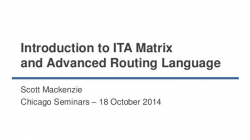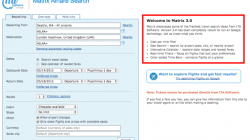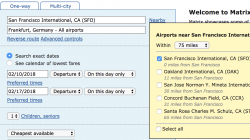I’m providing some step-by-step examples of real scenarios to help people learn to use ITA Matrix based on feedback from this blog and my Chicago Seminars presentation. Let’s imagine you want to book a flight, and because you’re a member of United MileagePlus, you want to book a flight on a Star Alliance carrier. The first step is to open ITA Matrix, plug in your dates and cities, and then add a little advanced routing language. (If you don’t know what I’m talking about, check out my introduction to ITA Matrix).
In this case we’re going from Chicago to Spain, sometime in December. Because it’s cold in Chicago and there’s never a bad time to visit Barcleona. 😉 We’ve used the advanced routing language “/alliance [name]” to perform this search. There are three alliances you can use this with, and the only thing to watch out for is that you may exclude some airlines that are partners but not alliance members, e.g., Alaska Airlines and Etihad are non-alliance partners with American Airlines.
/alliance oneworld
/alliance star-alliance
/alliance skyteam
Our first set of results shows outbound flights. These are sorted by price, with the lowest price always in orange. I prefer the “Time bars” display format (indicated in the upper right corner) though there are other options available. The reason to use “Time bars” is that is shows many flights at once in an easy-to-digest format. If you choose “Complete trips” it attempts to show all possible combinations of outbound and return flights. Choosing “Individual flights” only shows the outbound but still makes it hard to comprehend.
By clicking on the PRICE button you can change the sort options to “Sort by price per mile.” I like to do this so I can see if there may be an option that is slightly more expensive but earns many more miles. These aren’t always easy to spot. There might be 20 different options at the same price and another 20 for only $5 more. But perhaps one option is 20% longer and only $10 more. You could easily overlook it. So I always use both sort options.
In order to sort by price per mile you MUST use a specific URL to access ITA Matrix: matrix.itasoftware.com/?showPricePerMile=true. It doesn’t change anything about how the site operates except by enabling this feature.
Now we can see that the first flight on the list is about $85 more but significantly longer distance. Turkish is a decent airline and has a pretty good lounge in Istanbul. If you hover on any part of the itinerary — a particular flight or a connecting airport — you can learn more details.
But if you skip ahead, you’ll find out that selecting this flight only gives us one return option. It’s not a very flexible itinerary. So I’m going to choose one of these two Lufthansa itineraries instead that go through Munich. They have the advantage of being much cheaper and more convenient. More time in the sun! In fact, you could pick the latter of these two and get a long layover in Munich, perhaps even running into town to visit the Christmas markets.
After selecting my outbound itinerary you can see it up at the top of the screen as “Flight 1” with my return options below. There are many return flights to choose from, and you can see that the prices still vary (the lowest option in orange is further down the list and not shown here because we’re still sorting by price per mile.)
Worth noting: the price you see is always the lowest possible price and can go up. It means that if you pick that flight on the outbound there is at least one return option that you can choose and keep that price. Other return options may be higher. If you are doing a multi-city itinerary, you have more than one chance to pick a more expensive flight, but there will always be at least one option that sticks to the original quote. You can even change the order of your choices if you like. Sometimes I prefer to pick my return flight first because I’m more particular about the time I arrive or depart. Just click on “Flight 1” or “Flight 2” at the top to pick an option for that part of your itinerary.
Once you have all your trips selected you’ll come to the final page with your complete itinerary. It shows the cities, times, dates, aircraft, and cabin and fare class. Although you can’t book a ticket on ITA Matrix, you should be able to find a website somewhere that will charge you the same price (try the airline or Hipmunk before going to more obscure places). If you find a higher price quoted to you, then that website may be overcharging you, but there’s also a chance that ITA’s information is out-of-date. Look around a few times before you give up.
Below the itinerary is a blue box with the fare construction.
This box shows you all the different components that went into determining the cost of your flight. Although it doesn’t matter for most purposes, it will be useful to a travel agent if you decide to use one. Sometimes a travel agent can book a flight you can’t find online, but I’ve never had to resort to one. The airline may also be able to help if you call in. In particular, you’ll want to know the name of the fare. This is a string of letters and numbers and in this case it’s the same in both directions: LLXNC41S. Your itinerary may consist of one fare or many different fares.
You can also use this information to learn about the cost of an award ticket. If you want to know how much you will have to pay in taxes and fees, try looking up the same itinerary on ITA first as if you were going to buy it with cash. There are three main components of a fare:
The base fare is listed at the top and called out in bold letters. In this case we have two base fares of $135.50 each.
The fuel surcharge is listed near the top and usually indicated with the letters YQ or YR. Not all flights have a fuel surcharge (they tend to be for international travel). But the are often the largest single component of the fare. In this case it is $496.
Taxes and fees make up whatever’s left.
When you book an award ticket, your miles will always cover the base fare, and you will always have to pay the taxes and fees. Award programs differ in how they treat the fuel surcharge. British Airways will always make you pay the fuel surcharge, even if you fly on American Airlines. American Airlines will not impose a fuel surcharge for most awards — unless you book an award on British Airways. United Airlines never imposes a fuel surcharge.
The rules are determined by the program whose miles you are using, but as you see each program varies their application depending on who you choose to fly. Someone using American Airlines miles should probably try to fly on an American Airlines plane to avoid the fuel surcharge. Someone using British Airways Avios points should probably try to use them on domestic flights that don’t have fuel surcharges.













